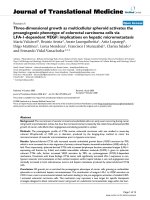Báo cáo hóa học: " Editorial Impact of Kirk’s Results on the Development of Fixed Point Theory" docx
Bạn đang xem bản rút gọn của tài liệu. Xem và tải ngay bản đầy đủ của tài liệu tại đây (414.99 KB, 2 trang )
Hindawi Publishing Corporation
Fixed Point Theory and Applications
Volume 2010, Article ID 821961, 2 pages
doi:10.1155/2010/821961
Editorial
Impact of Kirk’s Results on the Development of
Fixed Point Theory
Mohamed A. Khamsi
1, 2
and Tomas Dominguez-Benavides
3
1
Department of Mathematical Sciences, University of Texas at El Paso, El Paso, TX 79968, USA
2
Department of Mathematics and Statistics, King Fahd University of Petroleum & Minerals, P.O. Box 411,
Dhahran 31261, Saudi Arabia
3
Departamento de An
´
alisis Matem
´
atico, Universidad de Sevilla, 41080 Sevilla, Spain
Correspondence should be addressed to Mohamed A. Khamsi,
Received 31 December 2010; Accepted 31 December 2010
Copyright q 2010 M. A. Khamsi and T. Dominguez-Benavides. This is an open access article
distributed under the Creative Commons Attribution License, which permits unrestricted use,
distribution, and reproduction in any medium, provided the original work is properly cited.
“The theory of Fixed Points is one of the most powerful tools of modern mathematics” is a
quote by Felix Browder, who in the mid-nineteen sixties gave a new impetus to the modern
fixed point theory via the development of nonlinear functional analysis as an active and
vital branch of mathematics. The metric fixed point theory is a rather loose knit branch of
fixed point theory concerning methods and results that involve properties of an essentially
isometric nature. The divide between the metric fixed point theory and the more general
topological theory is often a vague one. The use of successive approximations to establish
the existence and uniqueness of solutions is at the origin of the metric theory. It goes back to
Cauchy, Liouville, Lipschitz, Peano, Fredholm, and especially Picard. However, it is the Polish
mathematician S. Banach who is credited with placing the underlying ideas into an abstract
framework suitable for broad applications well beyond the scope of elementary differential
and integral equations.
Kirk’s fixed point theorem published in 1965 had a profound impact on the
development of the fixed point theory over the last 40 years. Through the concept of
generalized distance, Tarski’s classical fixed point theorem may be seen as a variant of
Kirk’s fixed point theorem in discrete sets. This shows among other things the power of this
theorem.
This special issue focused on many types of applications of Kirk’s fixed point t heorem.
It included nonexpansive mappings in Banach and metric spaces, multivalued mappings in
Banach and metric spaces, monotone mappings in ordered sets, multivalued mappings in
ordered sets, applications to nonmetric spaces like modular function spaces, and applications
to logic programming and directed graphs.
2 Fixed Point Theory and Applications
The special issue contains 38 papers accepted. Most of the papers touched on all
applications of Kirk’s fixed point theorem.
Mohamed A. Khamsi
Tomas Dominguez-Benavides









